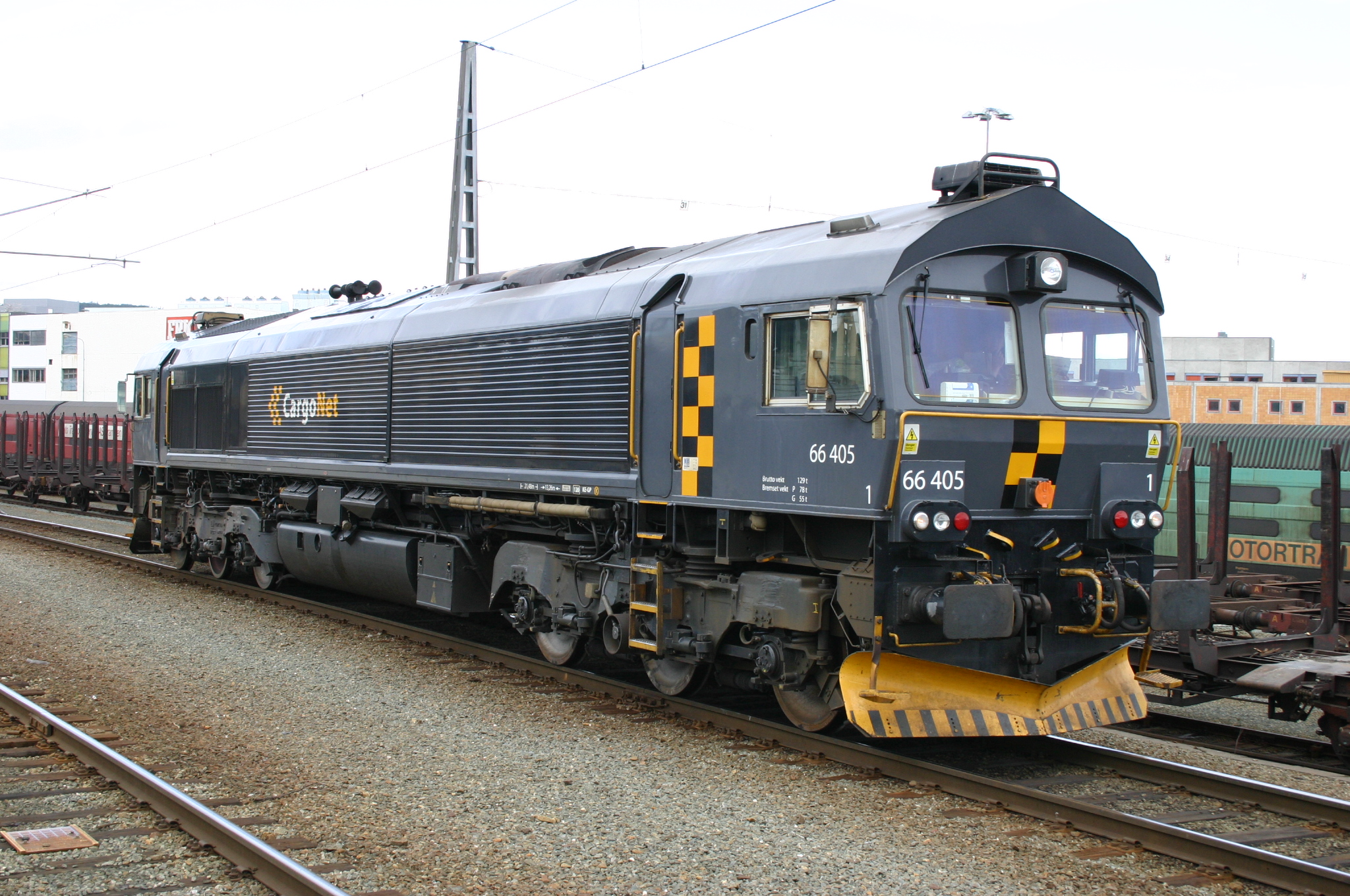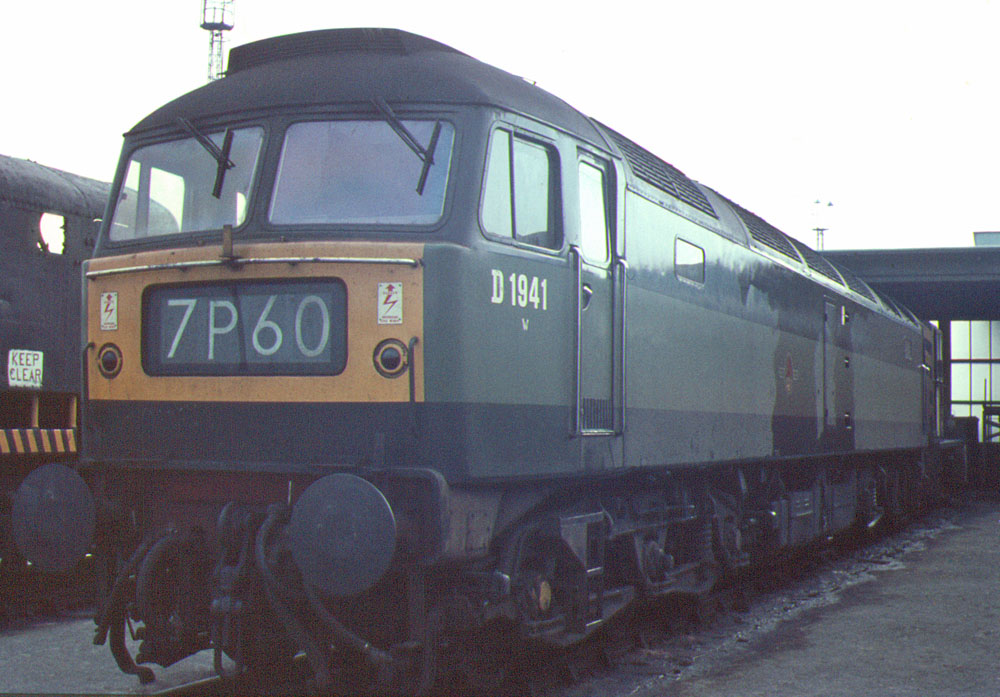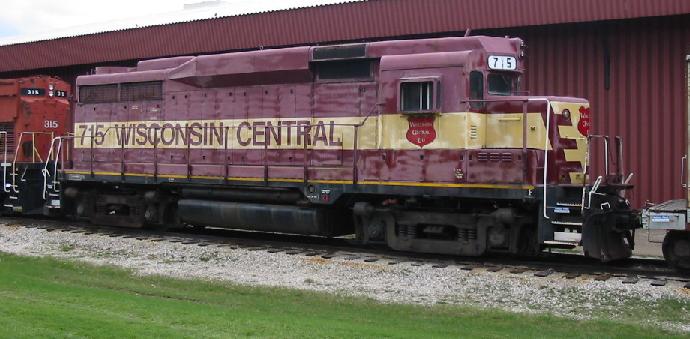|
British Rail Class 66
The Class 66 is a type of six-axle diesel-electric freight locomotive developed in part from the , for use on the railways of the UK. Since its introduction the class has been successful and has been sold to British and other European railway companies. In Continental Europe it is marketed as the EMD Class 66 (JT42CWR). History Background On the privatisation of British Rail's freight operations in 1996, Wisconsin Central Transportation Systems under the control of Ed Burkhardt bought a number of the newly privatised rail freight companies: Transrail Freight, Mainline Freight, Loadhaul, and later, Railfreight Distribution and Rail Express Systems; thus controlling 93% of UK rail freight. After a public relations exercise involving the input of the general public, the company was named English Welsh & Scottish Railway (EWS). EWS inherited a fleet of 1,600, mainly diesel, locomotives, with an average age of over 30 years; 300 had been cannibalised for spares. Typical of t ... [...More Info...] [...Related Items...] OR: [Wikipedia] [Google] [Baidu] |
EMD JT42CWR
The Electro-Motive Diesel (EMD) Class 66 (or JT42CWR) are Co-Co diesel locomotives built by EMD for the European heavy freight market. Designed for use in Great Britain as the British Rail Class 66, a development of the Class 59, they have been adapted and certified for use in other European countries. Outside Europe, 40 locomotives have been sold to Egyptian Railways for passenger operation. A number of locomotives built for Euro Cargo Rail in France with roof-mounted air conditioning are classed ''Class 77''. In Germany ECR units operated for DB Schenker were numbered as class 247, re-classified as class 266 by the Eisenbahn-Bundesamt to match other Class 66 locomotives operating in Germany. History United Kingdom The class was designed by General Motors-Electro Motive DivisionIn 2005 General Motors sold its locomotive manufacturing division (EMD), the organisation is now named Electro Motive Diesel or EMD for use in the UK, and 250 were sold to English Welsh & Scotti ... [...More Info...] [...Related Items...] OR: [Wikipedia] [Google] [Baidu] |
Direct Rail Services
Direct Rail Services (DRS) is a rail freight company in Great Britain. As of 2022, it is one of seven publicly owned railway companies in the United Kingdom, the others being NI Railways (the passenger rail operator in Northern Ireland), LNER, Northern Trains, Southeastern, Transport for Wales Rail and ScotRail. DRS was created as a wholly-owned subsidiary of British Nuclear Fuels Ltd (BNFL) during late 1994 with the primary purpose of taking over the rail-based handling of nuclear material from British Rail. As early as 1997, the company begun diversified into other operations, initially bidding for contracts to haul freight traffic for other companies such as Tesco and Eddie Stobart Group. Furthermore, DRS has branched into passenger services, these have included charters, such as the Northern Belle, and contracts with operators such as National Express East Anglia, Chiltern Railways, and Arriva Rail North. Additional rolling stock, such as the Class 57 and Class 88 lo ... [...More Info...] [...Related Items...] OR: [Wikipedia] [Google] [Baidu] |
British Rail Class 47
The British Rail Class 47 or Brush Type 4 is a class of diesel-electric locomotive that was developed in the 1960s by Brush Traction. A total of 512 Class 47s were built at Brush's Falcon Works in Loughborough and at British Railways' Crewe Works between 1962 and 1968, which made them the most numerous class of British mainline diesel locomotive. They were fitted with the Sulzer 12LDA28C twin-bank twelve-cylinder unit producing though this was later derated to to improve reliabilityand have been used on both passenger and freight trains on Britain's railways for over 55 years. Despite the introduction of more modern types of traction, a significant number are still in use, both on the mainline and on heritage railways. As of December 2021, 78 locomotives still exist as Class 47s, including 31 which have been preserved. 33 further locomotives were converted to Class 57s between 1998 and 2004. Origins The Class 47 history begins in the early 1960s with the stated aim of t ... [...More Info...] [...Related Items...] OR: [Wikipedia] [Google] [Baidu] |
Railway Gazette
''Railway Gazette International'' is a monthly business magazine and news website covering the railway, metro, light rail and tram industries worldwide. Available by annual subscription, the magazine is read in over 140 countries by transport professionals and decision makers, railway managers, engineers, consultants and suppliers to the rail industry. A mix of technical, commercial and geographical feature articles, plus the regular monthly news pages, cover developments in all aspects of the rail industry, including infrastructure, operations, rolling stock and signalling. History ''Railway Gazette International'' traces its history to May 1835 as ''The Railway Magazine'', when it was founded by Effingham Wilson. The ''Railway Gazette'' title dates from July 1905, created to cover railway commercial and financial affairs. In April 1914 it merged with ''The Railway Times'', which incorporated '' Herapath's Railway Journal'', and in February 1935 it absorbed the ''Railway Engi ... [...More Info...] [...Related Items...] OR: [Wikipedia] [Google] [Baidu] |
Rail Express Systems
Rail Express Systems (RES) was a sector of British Rail. This sector was responsible for transport of mail and parcels, including the travelling post office trains, as well as taking over charter operations from InterCity and haulage of the Royal Train. RES had been created out of a policy of Sectorisation, its functions previously being undertaken as an integral element of British Rail in the 1980s. Initially known simply as the ''Parcels Sector'', it was decided to re-brand it as ''Rail Express Systems'' during late 1991. The entity's management team sought to improve the economics of its operations and to better satisfy its customer's needs, the principal one being the Royal Mail. Thus, various initiatives were undertaken, including the procurement of new rolling stock in the form of 16 four-car British Rail Class 325, a series of electric multiple units built exclusively for moving mail. During the mid-1990s, RES implemented a £150 million strategy that focused on long- ... [...More Info...] [...Related Items...] OR: [Wikipedia] [Google] [Baidu] |
Railfreight Distribution
Railfreight Distribution was a sub-sector of British Rail, created by the division in 1987 of British Rail's previous Railfreight sector. It was responsible for non-trainload freight operations, as well as Freightliner and Intermodal services. In its early years, the division was occasionally referred to as Speedlink Distribution. It was later responsible for freight operations through the Channel Tunnel. History In the 1980s, freight traffic on the railway was in decline, due to a mixture of increased competition from road transport, a shrinking network that had reduced rail's reach and a decline in the domestic manufacturing industry, reducing internal demands for raw materials and transport of finished product for export. By the late 1980s, British Rail In October 1988, took three troublesome divisions of their freight operations; Speedlink ( wagonload), Freightliner (Container), Railfreight International (International traffic) and merged them into one entity, Railfreight ... [...More Info...] [...Related Items...] OR: [Wikipedia] [Google] [Baidu] |
Loadhaul
Loadhaul Ltd. was a railfreight operator based in the north-east of the United Kingdom. It was formed in 1994, as part of the privatisation of British Rail, and acquired in 1996 by a consortium headed by Wisconsin Central, then merged into a new company English Welsh & Scottish Railway. It is now part of DB Cargo. History Loadhaul was created in 1994, along with Transrail and Mainline as part of the broadly regional split of British Rail's Trainload Freight operations - Loadhaul's centre of operations were North East England, and South and East Yorkshire. The three companies were created with the aim of promoting competition between the businesses with the eventual aim of being privatised. It was initially and briefly named "Trainload Freight North East Limited" before being renamed Loadhaul Limited. All three former Trainload Freight companies including Loadhaul were acquired in February 1996 by 'North-South Railways': a company formed by a consortium led by US railroad ... [...More Info...] [...Related Items...] OR: [Wikipedia] [Google] [Baidu] |
Mainline Freight
Mainline Freight was a trainload rail freight operator based in Islington, London, England with operations extending to Yorkshire in the north and Somerset in the west. It was formed from part of British Rail's Trainload Freight division as part of the privatisation of British Rail. Mainline Freight, Loadhaul and Transrail were purchased by a consortium led by Wisconsin Central in 1996 and amalgamated into a new company, English Welsh & Scottish. History Mainline Freight was created in 1994 along with Transrail and Loadhaul as part of the broadly regional split of British Rail's Trainload Freight operations - Mainline Freight's centre of operations were South East England, and East Anglia, and the East Midlands. Three companies were created with the aim of promoting competition between the businesses.Sources: * * It was initially and briefly named "Trainload Freight South East Limited" before being re-branded in September 1994. All three former Trainload Freight companie ... [...More Info...] [...Related Items...] OR: [Wikipedia] [Google] [Baidu] |
Transrail Freight
Transrail was a trainload rail freight operator based in St Blazey, England, UK with a large operating area including Scotland, Wales and the west of England. It was formed in 1994 from part of British Rail's Trainload Freight division, as part of the privatisation of British Rail. Mainline Freight, Loadhaul and Transrail were purchased by a consortium led by Wisconsin Central in 1996 and amalgamated into a new company, English Welsh & Scottish. History Transrail was created in 1994 along with Mainline Freight and Loadhaul as part of the broadly regional split of British Rail's Trainload Freight operations. Transrail had the largest operating area of the three companies, operating in Scotland, Wales and the entire west of England (South West, West Midlands, and North West). The three companies were created with the aim of promoting competition between the businesses. It was initially and briefly named "Trainload Freight West Limited" before being re-branded in July 1994. T ... [...More Info...] [...Related Items...] OR: [Wikipedia] [Google] [Baidu] |
Ed Burkhardt
Edward Arnold Burkhardt is a railroad executive, the founder and current chairman of Rail World Inc. Career After gaining a B.S. with honors in Industrial Administration from Yale University and studying Rail Transportation at Yale's graduate school, Burkhardt initially worked for the Wabash Railroad. He was then an executive with Chicago and North Western Transportation, first as vice president of marketing and then vice president of operations. Wisconsin Central Transportation Corporation Following passage of the Staggers Rail Act, on April 3, 1987, Soo Line Railroad announced the sale of its Lake States Transportation Division to private investors led by Burkhardt and Thomas F. Power Jr., former chief financial officer at the Milwaukee Road, creating the new Wisconsin Central Transportation Corporation. The first WC train ran from Stevens Point to North Fond du Lac, Wisconsin on October 11, 1987. Burkhardt served as chairman, president and chief executive officer of the ... [...More Info...] [...Related Items...] OR: [Wikipedia] [Google] [Baidu] |
Wisconsin Central Ltd
Wisconsin Central Ltd. is a railroad subsidiary of Canadian National. At one time, its parent Wisconsin Central Transportation Corporation owned or operated railroads in the United States, Canada (Algoma Central Railway), the United Kingdom ( English Welsh & Scottish), New Zealand (Tranz Rail), and Australia ( Australian Transport Network). Overview Wisconsin Central Ltd. (WC) started in US in the mid-1980s using most of the original Wisconsin Central Railway's rights of way and some former Milwaukee Road rights of way after the Soo Line Railroad acquired the Wisconsin, Illinois, Indiana, Missouri and Minnesota holdings of the bankrupt Milwaukee Road and divested its older railway trackage in Wisconsin. In 1993 the Wisconsin Central also acquired the Green Bay and Western Railroad and the Fox River Valley Railroad. In 1995, Wisconsin Central acquired the Canadian Algoma Central Railway whose tracks ran north of Sault Saint Marie to Hearst, Ontario. The Algoma Central runs ... [...More Info...] [...Related Items...] OR: [Wikipedia] [Google] [Baidu] |
Privatisation Of British Rail
The privatisation of British Rail was the process by which ownership and operation of the railways of Great Britain passed from government control into private hands. Begun in 1994, it had been completed by 1997. The deregulation of the industry was initiated by EU Directive 91/440 in 1991, which aimed to create a more efficient rail network by creating greater competition. British Railways (BR) had been in state ownership since 1948, under the control of the British Railways Board (BRB). Under the Conservative government of Margaret Thatcher elected in 1979, various state-owned businesses were sold off, including various functions related to the railways – Sealink ferries and British Transport Hotels by 1984, Travellers Fare catering by 1988 and British Rail Engineering Limited (train building) by 1989. It was under Thatcher's successor John Major that the railways themselves were privatised, using the Railways Act 1993. The operations of the BRB were broken up and sold ... [...More Info...] [...Related Items...] OR: [Wikipedia] [Google] [Baidu] |






